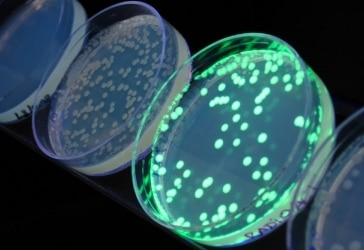Practical Application of Phenol-Chloroform Extraction
Are you struggling with your phenol-chloroform extraction or just looking to maximize the nucleic acid you retrieve? Then read our expert advice to improve your technique.
Join Us
Sign up for our feature-packed newsletter today to ensure you get the latest expert help and advice to level up your lab work.

Are you struggling with your phenol-chloroform extraction or just looking to maximize the nucleic acid you retrieve? Then read our expert advice to improve your technique.

Western Blotting is a long established method for which the protocol varies little from lab to lab. However, there are kits available and some tweaks that can be made to the protocols that may improve your results and reduce the time it takes you to execute this popular technique. Save Time by Co-Incubating the Primary…

While Luria-Bertani broth (LB) has long been the fuel that powered Molecular Biology and Biochemistry, there is an increasing movement towards more specialized and complex bacterial media formulations such as Terrific Broth (TB), Plasmid DNA Media (PDMR), and Autoinduction Media (ZYP-5052). These media formulations optimize E. coli cell growth and performance utilizing specialized carbon sources…

You have been toiling away at your thesis project for years and you think the end is in sight. Now the big question is “What’s next?” If you think you might want to move away from the bench, then you should check out our suggestions for alternative careers for scientists. If you think your future…
Merriam-Webster defines networking as “the cultivation of productive relationships for employment or business”. Less formally, networking is actively communicating with the other people you know (mostly scientists, in our case) for career advice and job openings, in addition to utilizing opportunities to meet new people for the same purpose. This is a core activity of…

For a long time we’ve been able to pinpoint the subcellular location of proteins, and the advent of FISH (Fluorescence in situ Hybridization) allowed us to locate the position of genes in the nucleus, but recent advances in RNA FISH are making it easier and easier to collect the same data about individual messenger RNAs….
A partial digest – typically done when you only want to cut one of two or more restriction sites in a DNA – can be a frustrating procedure to execute. The best advice anybody can give about partial digests is to avoid having to do them. However, there are times when there just aren’t many…

In parts one and two of this series I described how semi-permeable membranes and precipitation methods could be used to concentrate your protein-of-interest, but there is one more method that you may not have thought of for protein concentration – chromatography. While chromatography resins are an obvious choice for protein purification, they can also be…

While precipitation is an obvious choice for concentrating DNA and RNA samples, it can also be an effective way to concentrate proteins. Here in installment two of this three part series, I describe the two most common methods for protein precipitation – ammonium sulfate and trichloroacetic acid. Background Precipitation of proteins occurs primarily by hydrophobic…

This is the first of a three part series describing some of the most common methods for concentrating proteins. In later installments I’ll discuss using protein precipitation and chromatography to concentrate a protein. However, here I’ll detail the most popular approach – semi-permeable membranes, used for both dialysis and commercial protein concentrators. Structure of the…

If you purify proteins expressed in E. coli, then you’re probably familiar with this scenario: you come in bright and early in the morning and inoculate your large flasks of media with the overnight culture, start shaking them at 37 °C, and now you wait. And watch. And wait some more. You can’t venture far,…

This is the final installment in a four part series on writing your first paper. For the first part in the series, click here, for the second part, click here, and for the third, click here. After what has potentially (likely?) been years of data collection and a month or two of writing, re-writing, wailing and gnashing of teeth,…
This is part three of a four part series on writing your first paper. For the first part in the series, click here, for the second part, click here. Once you have written the first draft and handed it off to your mentor, the editing process begins. Depending on the personalities involved, this could be a…
This is part two of a four part series on writing your first paper. For the first part in the series, click here. You have been pounding away at your project, probably for a year… or two… or three… Anyhow, you now have a collection of figures that seem to tell quite a nice story,…

Most of us learn the art of writing papers on the job, often a painful process. In this four-part series, I’ll run you through my step-by-step approach to writing papers and, hopefully, help make the process of writing your first (or next) paper, a bit easier. As always, if you have any alternative advice or…

Microcentrifuges are pretty much the epitome of efficiency, but I have a couple of suggestions that may make using this instrument even easier. Divide by ThreeNot only is the number of tubes a microcentrifuge can hold divisible by two, but almost always by three as well. How does this help you? If you have an…

After picking a graduate program, the next big decision for a first-year graduate student is picking an advisor. One of the factors to consider in this decision is the academic age of the Professor and his or her lab. Do you want to work for the energetic Assistant Professor that joined the department last year,…

Have a healthy respect for the ultra! Here are some hints and tips for using a preparative ultracentrifuge, disaster free.

While almost all of you are probably familiar with the power of eBay to bring you everything from concert tickets to electronics to your very own Batmobile, you may not have realized that the world’s largest garage sale also has quite a collection of laboratory equipment. I’ve been turning to this source for equipment for…

The release of the iPad this week may bring the long-expected replacement of the paper-bound lab notebook by electronic notebooks one step closer. But are scientists, particularly PIs, comfortable with electronic lab notebooks? The rise of the tabletsThe concept of an electronic lab notebook isn’t anything new, and even the idea of implementing it on…

If you have ever attempted to load a SDS-PAGE gel only to miss the well, stab the divider, and then watch helplessly as your sample squirts off into the wrong well, then this tip is for you. The fortunate among us are able to use pre-cast gels with the wells outlined on the gel plate,…

The eBook with top tips from our Researcher community.